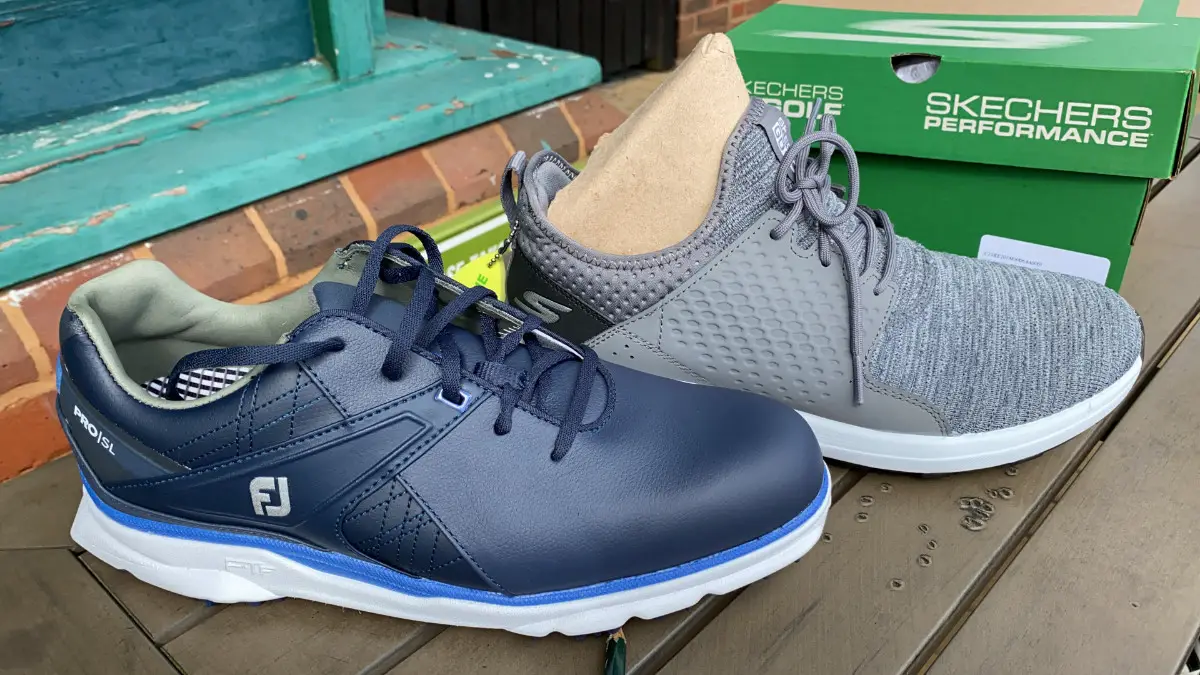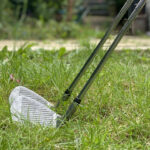We’ve all seen them out on the golf course, clad from top to tail in all the requisite regalia. Golfers plying their trade out on the fairway so often feel compelled to “look the part”, whether it’s the once obligatory plus fours or the more latterly compulsory sun cap.
It is perhaps understandable that those who venture forth to play golf should want to wear clothing that is both suitable and practical for the task at hand. But is wearing golf shoes – as opposed, say, to sneakers, flip flops or even sandals – strictly necessary in the sense of conferring any kind of playing advantage?
What are Golf Shoes?
Most professional sports have evolved to a place where it is advantageous to be wearing the right sports kit. Whether it be a helmet and padding for football or a pair of waders for course angling, whilst it is of course possible to follow those disciplines without sporting the desired wear doing so does tend to throw up unnecessary challenges.
Never was this more so than when choosing footwear appropriate for walking or running on grass. Sports people need in particular to combine maintaining good grip with the freedom to move at speed without being hindered by their attire. Proper golf shoes provide just that balance for extra confidence and more stability, allowing players the luxury of being able to perform their golf swing without fear of slipping or sliding just at the wrong time.
A Brief History of the Golf Shoe
They first appeared way back in 1891, some decades after The Golfer’s Manual had advised golfers to “wear shoes roughed with small nails or sprigs”. By the end of the nineteenth century players were taking advantage of new developments in golf wear technology to avail themselves of some of the earliest and most exquisite lines in spiked golf shoes. Rough around the edges for sure, but the die was irrevocably cast.
These early golf shoes featured detachable, screw-in spikes. And whilst they were certainly more functional than the clumsy spikeless shoes which preceded them, these aggressive metal spiked shoes presented a challenge to grounds keepers everywhere, who routinely complained about the damage which they inflicted upon greens in their wake.
The “Saddle Oxford” style was specifically designed in 1906 to address some of the issues surrounding what were then the more traditional golf shoes. Originally a form of tennis shoe intended for use when playing racket sports, they were notable for their saddle-shaped piece of leather around the lace area. In fact this formed the prototype design for golf shoes for many more decades to come, providing that unique look which we all know today. Tassels were added some time later.
Whilst the essential look remained more or less the same, golf shoes evolved down the years into something much more comfortable and practical. Added cushioning became a must, as did better traction and a design more sympathetic to the needs of professional golfers walking sometimes several miles during a round of golf. The long-standing issue of damage to golf courses was largely addressed when metal spikes were replaced with gentler, but equally effective plastic spikes or cleats, retaining the required extra grip without leaving carnage in their wake.
How Much Do Golf Shoes Cost?
Like almost any piece of equipment in golf or any other sport, golf shoes are a commodity which varies enormously in terms of price depending upon brand, design and quality. When you buy golf shoes it is possible to pick up a cheap, basic new pair for as little as $25, but by and large you will get what you pay for. They are unlikely to be manufactured by a reliable brand but, more importantly, they are unlikely to be waterproof or even comfortable.
At the other end of the range a good pair can set you back a cool $300, but they will at least keep your feet dry when playing golf in wet conditions. Many golfers if not most have a personal preference when it comes to brands of shoe. Adidas golf shoes are popular and enjoy a good reputation amongst professional golfers. Whether you wish to invest this much may also depend upon whether or not you only intend to buy one pair.
Is Wearing Golf Shoes Mandatory?
The large majority of golf courses do not insist that players wear golf shoes during a golf game. Indeed should you so wish you can wear sneakers, street shoes, cross trainers or your bathroom slippers. Whilst it is true that some luxury golf courses and country clubs do require that a pair of golf shoes be worn, most courses take a more relaxed approach.
The case for wearing golf shoes is not compulsion, but rather comfort. Undoubtedly they provide the player with more grip when ball striking, as well as some relief when walking for long distances around the course, sometimes in wet conditions.
The question then that we ought to be asking is not are golf shoes necessary, but are they desirable?
When is it Best Not to Buy Golf Shoes?
Bearing in mind that most golf shoes can be expensive, it is perhaps not a good idea for a novice to buy their first pair until or unless they are sure they are ready to commit to the sport. It is also perhaps not money well spent to buy a pair of golf shoes if the intention is only to play on the rarest of occasions. Wear tennis shoes or everyday pumps instead if you have them.
In terms of enhancing performance, this may be more an issue for more expert golfers in any case. Playing good shots may depend on maintaining a good grip and being confident upon the surface, but this is likely only to be so at the margins.
Make a decision first about your future in the sport. Getting fully kitted out can come later.
Should You Wear Spiked or Spikeless Golf Shoes?
Now here’s the thing – not all golf shoes these days are actually spiked! Although spikes were probably the central design feature of earlier models, there are circumstances in which operating without them can actually be beneficial to both you and your game, hence there is a market for them.
In price terms there is very little difference between the two. In all ranges of spiked and spikeless shoes for golf, there are good designs and there are the less good.
The spikeless “revolution” began somewhat by chance in 2010, when professional golfer Fred Couples ventured out during the Masters at Augusta in a spikeless pair of Eccos. His reason for doing so was as a means of alleviating chronic back problems which he had been enduring for some time, but it prompted fresh thinking in the golfing world. If grip and hold can be maintained wearing dedicated spikeless designs, why bother with spikes?
To be sure, there are still spiked models aplenty on the store shelves and many if not most golfers still prefer them, but these days one has a choice.
It is even the case that some golf courses actually prohibit golf shoes spikes as they can still damage greens, notwithstanding the fact that today’s designs tend to be more benign than those of yesteryear.
Who Makes Golf Shoes?
Unsurprisingly, most of the major manufacturers of sports footwear also provide golf shoes. Adidas, ASICS, Nike and Puma are amongst the largest of them. They will go wherever the demand is, and with 67 million people around the world actively participating in golf it can hardly be said that there isn’t a market.
But there are also manufacturers specific to the sport of golf, such as Callaway and FootJoy, who produce golf shoes on top of all the other specialist equipment which they offer. Some golfers much prefer to do business with companies who are experts in the sports as opposed to a generic supplier of sporting apparel.
Are Golf Shoes an Essential Feature of the “Golf Look”?
There are many good reasons to buy a pair of golf shoes, but the need to “look the part” isn’t one of them. At up to $300 a throw, there are easier and more cost-effective ways of striking a pose.
For those who spend a good deal of their time at the driving range or out on the fairway, a good quality golf shoe could possibly be considered an essential. When walking up to six miles around the golf course it is important that one’s footwear is comfortable, and not given to slipping on the grass when the conditions are damp.
Whether to invest in a pair of spikes or to go spikeless is something of a judgment call. Those who can afford to do so may well play safe and take ownership of a pair of both. This can be an especially sound call bearing in mind that the upmarket clubs sometimes insist upon spiked shoes whilst others actually prohibit them.




